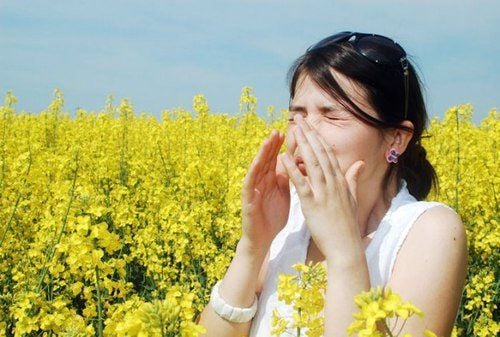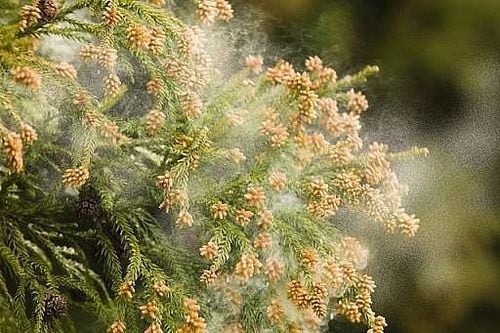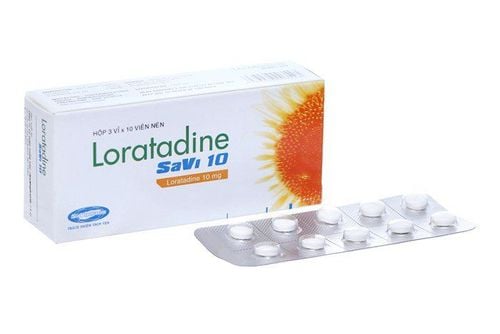This is an automatically translated article.
Hay fever, also known as allergic rhinitis or pollen allergy, is prominent with symptoms of seasonal diseases and diverse allergens such as animal dander, dust mites, pollen, mold spores, grass, .. Symptoms of dry fever can greatly affect a patient's life, reducing work productivity and daily activities.
1. What is hay fever?
Hay fever is a term for a form of allergic rhinitis that causes cold-like symptoms such as runny nose, congestion, sneezing, and sinus pressure. However, the cause is not a virus but an allergic reaction to outdoor or indoor allergens, such as pollen, dust mites, and animal dander.
See also: Pollen Allergic Rhinitis
In fact, this is an incorrectly used term because seasonal allergic rhinitis is not usually caused by hay fever or may not be associated with fever. Symptoms of allergic rhinitis usually appear immediately after a patient is exposed to a specific allergen. These symptoms include:

Viêm mũi dị ứng do phấn hoa
Runny nose stuffy nose Watery eyes or itchy eyes Sneezing Cough Itching of nose, roof of mouth or throat Feeling pressure and pain in facial sinuses Allergies Shiners: swelling, blue skin under eyes Decreased sense of taste
2. In which season is hay fever common?
In some patients, hay fever symptoms are worse at certain times of the year, usually in the summer, spring, or fall. However, there are individual cases of year-round symptoms due to patient sensitization to indoor allergens (dust mites, cockroaches, mold, pet dander)
Seasonal agents Causes of allergic rhinitis include:
Springtime common pollen Grasses Common spring and summer grass pollens Common fall weed pollens Fungal and mold spores are common in warm weather months pressure

Cây phấn hoa có thể gây nên viêm mũi dị ứng
See also: Allergic Rhinitis (Part I): Causes of the disease
Fever symptoms can start or get worse at a specific time of year due to the trigger of an agent such as tree pollen, grass or weeds at different times. Although hay fever can begin at any age, it is more likely to develop throughout childhood and early adulthood.
3. How is hay fever diagnosed?
In addition to the clinical symptoms mentioned, to diagnose hay fever, doctors may order the following 2 tests:
Skin prick test: small samples of different allergens are injected into the patient's skin patient, after about 20 minutes of evaluation for an allergic reaction, if there is an allergic reaction the area will develop a rash or hives Allergic blood test: draw blood from an arm vein to check for an allergen Hay fever can be easily confused with a cold because the symptoms are somewhat similar. However, hay fever lasts several weeks longer than a cold and does not cause a markedly high fever. The runny nose or phlegm of hay fever is more liquid and clear, while the runny nose or phlegm of the flu is usually thicker. Itching in the eyes, nose, and throat areas and skin is common in hay fever but not in colds.

Thuốc kháng histamin giúp giảm ngứa, hắt hơi và chảy nước mũi
4. Treatment of hay fever
The first thing when treating allergic rhinitis is to keep the patient away from the allergen. Medical treatment for hay fever may include the following:
Nasal spray corticosteroids: help prevent and treat rhinitis, itchy nose, and runny nose caused by hay fever Antihistamines: help relieve itching, sneezing and runny nose Decongestant: vasoconstrictor drug in the nose, helping to relieve nasal congestion caused by colds and allergies Oral corticosteroids: help relieve allergy symptoms effectively but long-term use has many side effects Nasal irrigation: is a solution It is an effective treatment that helps clear allergens from the nose and relieve symptoms. Hay fever usually appears immediately after the patient is exposed to the allergen and is common during the summer, spring and autumn. However, there are also cases that occur year round due to encountering allergens. Therefore, when detecting the disease, patients need to be monitored and periodically re-examined to prevent dangerous complications from occurring.
Otolaryngology - Vinmec International General Hospital is an address specializing in examination and treatment of common ear, nose and throat diseases such as rhinitis, allergic rhinitis, chronic rhinitis, tonsillitis, and pain. throat, tinnitus, non-allergic rhinitis, throat cancer; tumors of the head, face and neck, congenital malformations of the ear, nose and throat area by common surgical methods.
With a methodical implementation process from a team of experienced and qualified medical doctors will bring the best results to customers.
Please dial HOTLINE for more information or register for an appointment HERE. Download MyVinmec app to make appointments faster and to manage your bookings easily.













